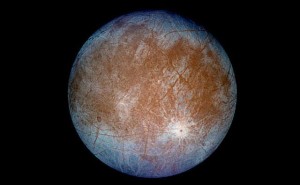Europa Moon Facts
Our greatest chance of finding life is possibly on this moon of Jupiter.
One of Jupiter’s four largest moons – the others being Io, Ganymede and Callisto – Europa is notable for its icy surface with a theorized ocean underneath. The moons all keep the same face towards Jupiter as they orbit. The layer of ice that encapsulates Europa’s entire surface is as little as 5-100 miles thick. It has one of the smoothest surfaces in the solar system, with its features such as valleys and hills no larger or deeper than a few hundred metres. This suggests it is young and still actively, forming like Earth.
Most of Europa is made of rock, although its core has a large iron content. Gravitational forces from Jupiter and its other three largest moons have given Europa a hot interior in a process known as tidal heating, similar to how tides are created on Earth as our moon stretches and pulls the oceans. Europa has a very thin atmosphere made of Just oxygen created by particles emitted from the radiation of Jupiter striking the surface and producing water vapour.
Due to there being almost no atmosphere on Europa, which is not much smaller than our moon, the temperature on the surface drops to -162″C at the equator and possibly as low as -220″C at the poles. Absolute zero is not much colder at -273″C. A few miles down into Europa’s ocean, the temperature could still be as cold as -30″C or as high as 0″C, meaning that any life would have to adapt to these freezing temperatures.
 The large amount of radiation Jupiter exerts can severely damage any probe attempting to reach Europa. One of the only missions to study the moon was the Galileo space probe, named after the astronomer Galileo who discovered Jupiter’s four largest moons in one week in 1610. It journeyed between Jupiter and its moons from 1995 to 2003, providing much of the information we know about Europa today.
The large amount of radiation Jupiter exerts can severely damage any probe attempting to reach Europa. One of the only missions to study the moon was the Galileo space probe, named after the astronomer Galileo who discovered Jupiter’s four largest moons in one week in 1610. It journeyed between Jupiter and its moons from 1995 to 2003, providing much of the information we know about Europa today.
Life on Europa
The lack of impact craters on the surface of Europa but the presence of fissures and cracks means that something other than meteorites must be fracturing and altering the ice. This has led scientists to believe there is an ocean of water beneath the icy surface of Europa.
It is in this ocean where life could reside. Previously, it was thought animals required sunlight to live, but the discovery of creatures living off small bacteria at the bottom of Earth’s oceans have raised the possibility that animals as large as fish could be living below Europa’s surface. There are two main theories as to how Europa’s ocean could look; thin ice sheet and thick ice sheet.

